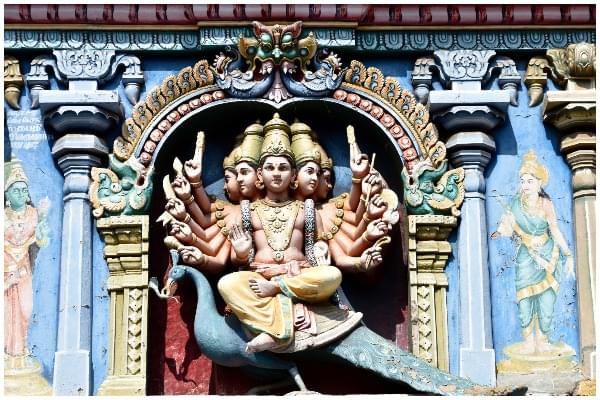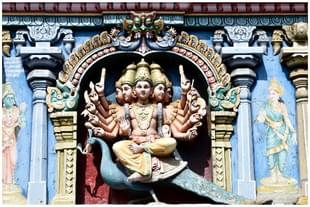Culture
Thaipusam Special: What The Six Faces Of Murugan Mean To A Kid And To An Elderly Devotee
Aravindan Neelakandan
Feb 11, 2025, 03:28 PM | Updated 03:57 PM IST
Save & read from anywhere!
Bookmark stories for easy access on any device or the Swarajya app.


In the heart of Tamil Nadu, where devotion and tradition are inseparable, Murugan, also known as 'Kanthan' or 'Skanda,' reigns supreme as the beloved Divinity of the Hindu Tamils.
He is the embodiment of wisdom and light, valour and love, a multifaceted God whose six faces reflect the depth and complexity of His divine attributes.
This reverence for Murugan is ingrained in Tamil culture and is evident in the prevalence of the name 'Shanmugam' (six-faced) and the profound significance of the number six in His bhakti and Puranic imagery.
From His six sacred abodes to the six syllables of His sacred mantra, the shadakshara, Murugan's sacred presence permeates the spiritual landscape of Tamil Nadu.
The six faces of Murugan, each embodying one of His divine attributes, emanate from the six heads of Shiva. While Shiva is traditionally depicted with five faces — Sadyojata, Vamadeva, Aghora, Tatpurusha, and Ishana — the emergence of Murugan called forth a sixth, the Adhomukha, the face of compassion gazing downward upon the world.
From the fiery power issuing forth from these six faces of Shiva, six divine infants were born, each a spark of the divine essence. These six were then united by the loving embrace of Goddess Parvati, merging into the single form of Skanda-Murugan, the six-faced God, embodying the fullness of Shiva's power and Parvati's grace.
The vibrant imagery of the Puranas serves as a spiritual-democratising force, translating the esoteric realities of yogic and tantrik traditions into accessible forms. These narratives generate sacred murtis, divine forms that become focal points for meditation, contemplation, and devotion.
In the case of Murugan, his six faces, enshrined in countless temples and depicted in vibrant art, become the representations of his divine attributes. Through lyrical verses and hymns, Hindu Tamils, from their earliest years, imbibe the mystical essence of Murugan's six-fold nature. This early exposure lays a foundation for those who later choose to delve deeper into spirituality, providing a familiar framework for their quest for divine union.
The most famous of the verses which describe the six faces of Murugan is the one written by 14th-century mystic, poet-genius Saint Arunagirinathar.
One face is that playful face that ascends the peacock and frolics. One face is that imparts the wisdom (meaning of Pranava) to Siva Himself. One face removes all the karma of devotees who seek that. One face pierces (and destroys) the mountain (of illusion) with the divine ‘Vel’. One face destroys the Asuric forces; One face is that which sought the loving marriage of Valli (the tribal girl). Thus impart to me the essence of the meaning of Your Six faces – You the Lord of Primordial Arunachala.
The inner meaning is not that hard to seek. A child learns to recite this verse when she is as young as five years old and commits it to memory. As she grows, the meaning of the verse expands within: ascend on my mind and make it Your vehicle (like the peacock). Become my guru and impart wisdom. Remove my karma. Shatter the mount of maya that traps me. Destroy the Asuras of ahamkara — the false sense of self. Dissolve the individual self with the Divine through the sacred union.
In Tamil culture, right from the Sangam days, the six faces of Murugan have always been an anchor for mystical devotion and yogic sadhana. Thirumurukaatrupadai of Nakeerar belongs to Sangam age. This text describes the six faces of Murugan with their divine functional dimensions:
The beatifically effulgent faces of Murugan arise in the inner vision of those who have abide by practices utterly devoid of anything negative. One face removes the darkness of the world with rays diversely radiant; One face sends forth with sweetness the boons sought by those devotees who sing His divinity; One face wills the completion of the Yajna of Vedic rulers conducted with perfection by the Brahmins who abide by tradition; One face with the pleasing coolness of the moon, explains to the seekers of wisdom the unknown difficult dimensions of spiritual knowledge; One face, apparently moving from the impartiality and assuming anger, destroying the enemies, does the Yajna of the battlefield; One face is ever smiling in blissful happiness as it looks at the beautiful and happy tribal girl with slender waist (Valli).Thirumurukaatrupadai (lines: 89-102)
Then the most famous mystical celebration of the six faces of Murugan comes from Kumaragurupara Swamigal of the 17th century.
A child who could not speak, he became a child prodigy, composing instant and in-depth poetry after a penance along with his parents at the temple of Thiruchendur Murugan.
His poem Kandar Kalivenba has the following depiction of the six faces of Muruga:
One face destroys the head of the Asuras – Soora- who was praised by the well armed, muscular Asuric forces and also destroys other Asuras; One face transforms the Karma and provides ever lasting life of eternal bliss; One face provides to the seekers, the ultimate wisdom that is the end and essence of all the Vedas and Agamas; One face assuming the radiant splendour of multiple suns, removes the darkness of the bondages and liberates; One face moon like is pleasant and sweet to both Valli and Devasena; One face verily a Divine Lotus provides all the boons of all nature to those who have surrendered themselves to His lotus feet.Kanthar Kalivenba lines: 82-94
The six faces of Murugan thus become the six key aspects of the Divine — enlightening the mind and guiding it to divinity, imparting wisdom of the highest order, destruction of the illusion (maya), liberation from the bonds of karma; vanquishing the ego (ahamkara) and uniting with such a transformed soul.
In many civilisations, the profound truths of spiritual experience remain confined to esoteric circles, guarded by secrecy and exclusivity.
Institutional religions often fear the democratisation of such knowledge, seeking to suppress it and even destroy it or, at best, tightly control its dissemination. On the other hand, Sanatana Dharma or Hinduism takes a radically different approach. It actively fosters the transmission of esoteric knowledge to children from their earliest years, embedding it within the very fabric of culture and daily life in melodious verses and lovely stories.
Through the captivating narratives of the Puranas, vibrant imagery in the temples and calendar art, and lyrical verses of the hymns of devotion, the deepest truths of Dharma are woven into the daily life of a Hindu child.
Whether a child grows up to be a mystic, a devotee, or a pragmatic worldly person, the seeds of spiritual understanding have been sown. These seeds may lie dormant for years, only to blossom later in life as the individual matures and their inner yearning for truth awakens. Or they may be passed on to future generations, ensuring the continuity of this profound wisdom, perhaps to dawn in a child generations later down the line.
This is unique to Hinduism: the highest knowledge is not hidden away in obscure texts or guarded by elite institutions. It is woven into the fabric of life, accessible to all who seek it. It permeates art, music, literature, and everyday rituals, creating an environment where spiritual understanding can organically emerge and flourish.
That is why we need to preserve this Dharma. We need to protect the six abodes of Murugan as we have protected them for generations against foreign aggressions. Those Hindus who spontaneously gathered to protect Thiruparankundram, one of the six holiest abodes of Murugan, did so to ensure that this Dharmic lineage and spiritual democracy is preserved, protected and handed over to posterity.





